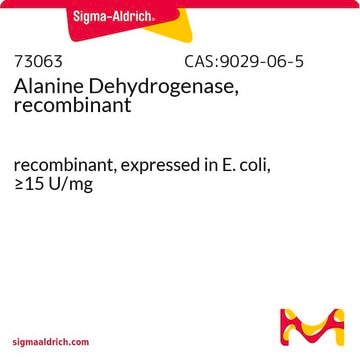A7653
L-Alanine Dehydrogenase from Bacillus subtilis
buffered aqueous glycerol solution, ~30 units/mg protein (Lowry)
Synonym(s):
L-Alanine: NAD+ oxidoreductase (deaminating)
Sign Into View Organizational & Contract Pricing
All Photos(1)
About This Item
Recommended Products
biological source
Bacillus subtilis
Quality Level
form
buffered aqueous glycerol solution
specific activity
~30 units/mg protein (Lowry)
foreign activity
LDH ~1% (using pyruvate as substrate)
storage temp.
−20°C
Looking for similar products? Visit Product Comparison Guide
Application
L-Alanine dehydrogenase converts L-alanine to pyruvate and ammonium. L-Alanine dehydrogenase from Bacillus subtilis may be used to study enzyme inactivation and protection .
Biochem/physiol Actions
L-Alanine dehydrogenase is an A-stereospecific dehydrogenase that catalyzes the reversible deamination of L-alanine to pyruvate and ammonium. It is important for the generation of pyruvate during sporulation. L-Alanine dehydrogenase from Bacillus subtilis has a predominately ordered kinetic mechanism in which NAD binds before L-alanine. Subsequently, ammonia, pyruvate, and NADH are released in that specific order. Optimal pH for the amination reaction is 8.8-9.0, whereas it is 10-10.5 for the deamination reaction. The enzyme is inactivated by divalent metal ions and p-chloromercuribenzoate, mercuric ion being most effective. The inactivation may be reversed by L- or D-cysteine.
Unit Definition
One unit will convert 1.0 μmole of L-alanine to pyruvate and NH3 per min at pH 10.0 at 25 °C.
Physical form
Solution in 50% glycerol containing 10 mM potassium phosphate buffer, pH 7.7
Signal Word
Danger
Hazard Statements
Precautionary Statements
Hazard Classifications
Resp. Sens. 1
Storage Class Code
10 - Combustible liquids
WGK
WGK 3
Personal Protective Equipment
dust mask type N95 (US), Eyeshields, Gloves
Certificates of Analysis (COA)
Search for Certificates of Analysis (COA) by entering the products Lot/Batch Number. Lot and Batch Numbers can be found on a product’s label following the words ‘Lot’ or ‘Batch’.
Already Own This Product?
Find documentation for the products that you have recently purchased in the Document Library.
D Delforge et al.
The Journal of biological chemistry, 272(4), 2276-2284 (1997-01-24)
L-Alanine dehydrogenase from Bacillus subtilis was inactivated with two different lysine-directed chemical reagents, i.e. 2,4, 6-trinitrobenzenesulfonic acid and N-succinimidyl 3-(2-pyridyldithio)propionate. In both cases, the inactivation followed pseudo first-order kinetics, with a 1:1 stoichiometric ratio between the reagent and the enzyme
Daniel Agren et al.
Journal of molecular biology, 377(4), 1161-1173 (2008-02-29)
L-alanine dehydrogenase from Mycobacterium tuberculosis catalyzes the NADH-dependent reversible conversion of pyruvate and ammonia to L-alanine. Expression of the gene coding for this enzyme is up-regulated in the persistent phase of the organism, and alanine dehydrogenase is therefore a potential
Sivagamisundaram Chavadi et al.
Journal of bacteriology, 191(24), 7545-7553 (2009-10-13)
To better understand the global effects of "natural" lesions in genes involved in the pyruvate metabolism in Mycobacterium bovis, null mutations were made in the Mycobacterium tuberculosis H37Rv ald and pykA genes to mimic the M. bovis situation. Like M.
A Sinem Ozyurt et al.
Proteins, 72(1), 184-196 (2008-01-25)
This study describes a method to computationally assess the function of homologous enzymes through small molecule binding interaction energy. Three experimentally determined X-ray structures and four enzyme models from ornithine cyclo-deaminase, alanine dehydrogenase, and mu-crystallin were used in combination with
Roxane Lahmi et al.
Journal of bacteriology, 188(14), 5258-5265 (2006-07-04)
Degradation of the cyanobacterial light-harvesting antenna, the phycobilisome, is a general acclimation response that is observed under various stress conditions. In this study we identified a novel mutant of Synechococcus elongatus PCC 7942 that exhibits impaired phycobilisome degradation specifically during
Our team of scientists has experience in all areas of research including Life Science, Material Science, Chemical Synthesis, Chromatography, Analytical and many others.
Contact Technical Service








